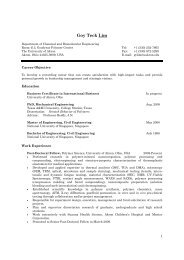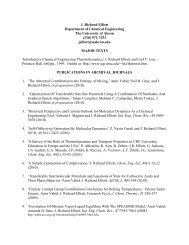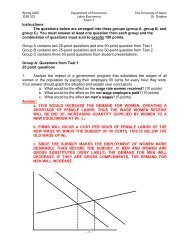Sociology of the Anarchists - Gozips.uakron.edu - The University of ...
Sociology of the Anarchists - Gozips.uakron.edu - The University of ...
Sociology of the Anarchists - Gozips.uakron.edu - The University of ...
Create successful ePaper yourself
Turn your PDF publications into a flip-book with our unique Google optimized e-Paper software.
information exchange. <strong>The</strong> Independent Media Center (“Indymedia”) movement is<br />
ano<strong>the</strong>r mechanism by which anarchists have used for mobilization. 41 Tilly references <strong>the</strong><br />
acquisition <strong>of</strong> weapons for <strong>the</strong> purpose <strong>of</strong> violent overthrow; to this point North<br />
American anarchists have not made explicit (and perhaps never have) moves towards<br />
amassing armaments. 42 <strong>The</strong> Anarchist Black Cross (ABC) is an example <strong>of</strong> a group that<br />
believe in armed self-defense and could better fall under Tilly's point than most o<strong>the</strong>r<br />
American anarchist organizations could.<br />
Common interest is perhaps <strong>the</strong> best thing that has propelled anarchist organizing thus<br />
far. <strong>The</strong>re are two ways in which anarchists (and all o<strong>the</strong>r individuals <strong>of</strong> various political<br />
philosophies): a) explicitly anarchist organizations or b) non-anarchist organizations.<br />
Obviously explicitly anarchists organizations are less-relevant to Tilly's third component.<br />
Non-anarchist organizations on <strong>the</strong> left, however, frequently have anarchists involved.<br />
From <strong>the</strong> anti-corporate globalization movement to environmentalism/eco-defense,<br />
multicultural movements, GLBT movement, and feminism, active, embedded anarchists<br />
can be found. Even in what some consider to be “reform” organizations, one can find<br />
active anarchist participation, such as in union organizing, living wage campaigns, antipolice<br />
brutality organizations, campaign finance reform initiatives, and so on. Albert<br />
(2001) explores <strong>the</strong> differences between what he calls non-reformist reforms and<br />
reformism:<br />
What's needed instead isn't to have no reforms, which<br />
would simply capitulate <strong>the</strong> playing field to elites, but to<br />
fight for reforms that are non-reformist, that is, to fight for<br />
reforms that we conceive, seek, and implement in ways<br />
leading activists to seek still more gains in a trajectory <strong>of</strong><br />
change leading ultimately to new institutions. (para.)<br />
When participating in non-anarchist organizations, anarchists will try to interject antiauthoritarian<br />
viewpoints and actions into both <strong>the</strong> internal structure <strong>of</strong> <strong>the</strong> organization<br />
and to <strong>the</strong> external operation and goals <strong>of</strong> <strong>the</strong> organization. This influence can be most<br />
vividly seen in <strong>the</strong> direct action movement (which is not explicitly anarchist, but heavily<br />
anarchist influenced). It utilizes many anarchists techniques: affinity groups, consensus<br />
decision-making, and (<strong>of</strong> course) direct action. <strong>The</strong>se components can also be seen in<br />
o<strong>the</strong>r progressive/left/radical organizations.<br />
Tilly's final component, opportunity, is very difficult to comment on; <strong>the</strong>re has been no<br />
anarchist revolution to occur in <strong>the</strong> United States (and few o<strong>the</strong>r countries—<strong>the</strong> most<br />
commonly <strong>of</strong>fered examples <strong>of</strong> anarchist revolution are 1930s Spain and present-day<br />
Chiapas, Mexico). Anarchist “evolution” has taken place in various ways. In considering<br />
such evolution, one must view social change as deeply integrated into <strong>the</strong> ideals <strong>of</strong> <strong>the</strong><br />
Enlightenment, and very close to left-libertarianism (or anarchism). 43<br />
41 For more information on <strong>the</strong> anarchist tendencies <strong>of</strong> <strong>the</strong> IMC movement (incidentally heavily-populated<br />
by anarchists), please see <strong>the</strong> chapter entitled “Indymedia”.<br />
42 Which is not to say that all anarchists are opposed to <strong>the</strong> use <strong>of</strong> “violence”. Please see <strong>the</strong> chapter<br />
“Violence” for a deeper discussion.<br />
43 For detailed description <strong>of</strong> <strong>the</strong> links between anarchism, classical Liberalism, and <strong>the</strong> Enlightenment, see<br />
Noam Chomsky's seminal essay (1970) “Notes on Anarchism”.<br />
[ Williams 47 ] [ this is a draft. do not cite. ]






